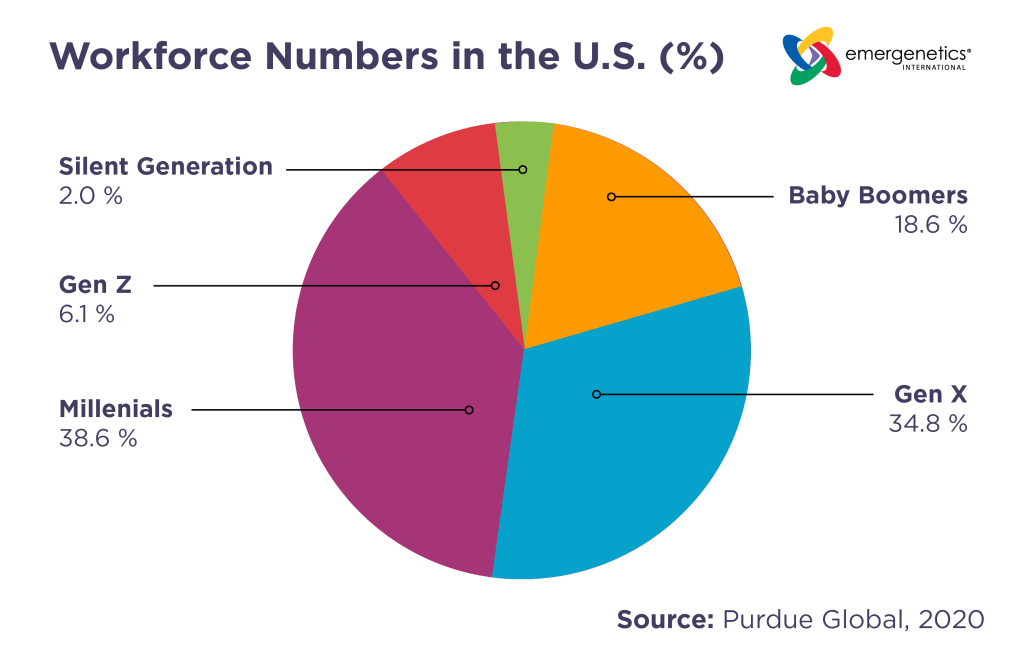
In today’s workplace, bridging generational gaps is not simply a necessity—it’s an opportunity to create a cohesive culture. With five generations in the workforce, it has become increasingly important to align colleagues of different age groups and backgrounds. The current breakdown of each generation in the workplace includes:

Every age group has different lived experiences, which influence and shape their communication tendencies. Purdue Global identified a few of these distinctive styles:
- Silent Generation (or Traditionalists): Value a personal touch in dialogue and prefers handwritten notes over email
- Baby Boomers: Employ a more formal approach and utilize the most efficient medium for conversation, including phone calls or face-to-face
- Generation X: Favor an informal, concise style and tend to use whatever method is most productive
- Millennials: Prefer digital platforms such as email, text and messaging platforms and find phones inefficient
- Gen Z: Like to use social media, text and messaging platforms and tend to expect quick responses
Having varied working styles can lead to misunderstandings. And miscommunication is commonly experienced because different generations often interpret the same thing in distinct ways. Let’s take the example of emojis and punctuation. A more seasoned colleague may be concerned when a younger colleague doesn’t use periods while exchanging chats, interpreting the action as a lack of attention to detail. However, younger generations may feel that periods indicate a more serious tone (FlexJobs). Another example comes from an ellipsis (the “…”). Older generations typically use this punctuation to create intrigue or suggest a loss of thought, whereas millennials and Gen Z may view ellipses as passive aggressive.
Any misperception may cause tension. If left unaddressed, coworkers may choose not to communicate with one another unless necessary, leading to inefficiency and missed opportunities for productive collaboration.
To avoid generational dissonance, employees should accept that all communication styles have their merits. When every team member learns to prioritize mutual understanding, it will result in a more dynamic work environment. To cultivate optimal communication in a multigenerational workplace, I recommend five steps.
A Cross-Generational Communication Action Plan
1. View Generational Diversity as a Strength
With differing ages comes a treasure trove of varied perspectives, experiences and skills. Recognizing and valuing these differences will enrich the organizational culture as well as drive innovation and problem-solving. Promote an inclusive environment where every voice is heard to unlock the employee base’s full potential. Encourage open dialogue to create a sense of belonging and inspire employees to use one another’s experiences to support the organization’s success.
2. Create Conversation Around Communication Styles
Minimize misunderstandings by discovering the preferred approaches of coworkers. While generational tendencies do exist, an individual’s style may not always align with the inclinations of their age group. A best practice is to ask employees what their communication preferences are, rather than assuming. Taking time to learn about the preferred methods, platforms and tone of colleagues will help to strengthen working relationships.
To better accommodate the varying preferences of coworkers, consider looking into a professional development tool like Emergenetics to support your organization in addressing misalignments. By gaining awareness of each person’s innate Thinking and Behavioral preferences as well as their implications for communication, personnel can close intent-impact gaps and work with greater efficiency.
3. Assume Positive Intent
When employees choose to operate with positive intent, it takes the tension out of misunderstandings and improves cross-generational relationships. To adopt this mindset, encourage workers to:
- Pause after receiving a message, take a few minutes to consider the contents carefully
- Check in with themselves to assess how they are feeling and what is fact versus perception
- Choose to give coworkers the benefit of the doubt, recognizing that we may interpret similar information in dissimilar ways
- Consider if they are reacting or responding
- Ask questions of colleagues to clarify their meaning
By taking time to reflect, individuals will be less likely to jump to conclusions. Acting with grace toward coworkers will also create space for understanding should future errors occur because, after all, we are all human.
4. Encourage Multigenerational Mentorship
A mentorship program can help staff get familiar and comfortable working with people who come from different age groups. Communication will flow more easily when relationships between younger and more experienced colleagues are already established. Pair cross-generational employees together to encourage continuous learning and growth as well as help employees develop a deeper understanding and respect for each other’s viewpoints, styles and worldviews.
5. Promote a Feedback Culture
To realize their potential, it’s essential for employees to receive feedback. Part of this practice requires staff at all levels to prioritize listening and empathy. By embracing these traits, personnel in different age groups can gain a new understanding of one another as well as discover changes they can make to better support the productivity and success of the team. When providing feedback, be sure to state how the input supports the organization’s vision and goals. Doing so will allow staff to take in commentary more positively, and less personally. It will also help promote collaboration by reinforcing that everyone is on the same team, working toward the same goals.
Addressing generational differences in communication does more than mitigate challenges. It encourages employees to embrace diversity and work together to propel the organization forward.
Discover how Emergenetics can help reduce miscommunication. Visit our website or fill out the form below to speak with one of our team members today!
 Print This Post
Print This Post

